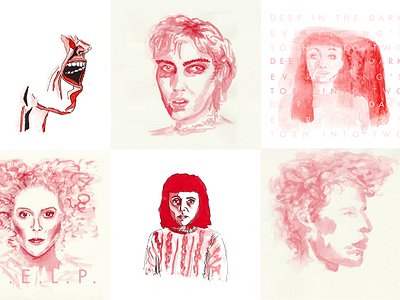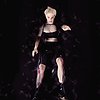Part 2
Could you describe your creative process on the basis of a piece or album that's particularly dear to you, please? Where did the ideas come from, how were they transformed in your mind, what did you start with and how do you refine these beginnings into the finished work of art?
With lyrics, I have found that the biggest stumbling block for me is when I don’t fully believe in the sentiment behind what I’m working on. But I’m grateful for this. If I’ve ever sat down and tried to write music that oversimplifies something I really care about, then at some point I probably hit a wall. I sometimes write myself a letter to really get to the root of what I’m trying to say. I look at She Knows (our last EP) as the first record where every word and note was built on a really honest, focussed foundation. The record is about equality and autonomy, particularly from a female perspective. We talked a lot as friends about the subjects we covered, and tried as much as possible to weave the music and lyrics together. The tracks are interlinked as a way of keeping a visual and narrative going throughout the record.
There are many descriptions of the ideal state of mind for being creative. What is it like for you? What supports this ideal state of mind and what are distractions? Are there strategies to enter into this state more easily?
Strangely, I find that with music I like to be more relaxed to create, but with visual work, I need a sense of urgency. I’m not sure what influences the different streams – maybe I’m more at risk of second-guessing my visual work, so by giving myself a short deadline, I don’t allow myself too much room for self-doubt. In terms of distractions, if I want them, I will find them anywhere. If the fridge has been deep-cleaned, then I’m probably putting something off.
Do you tend to listen to the music in question a lot or at all while working on the project? Is your approach more guided by the emotions or ideas stirred by the music or conceptual considerations?
Definitely stirred by the music! Once the marketing-hat bit is done, I’m all about letting the energy of the music influence me. Honestly, getting serious about illustration has turned me into a better music fan! I feel like I’m 15 years old again – that girl was extremely excited about music!
What kind of materials have proven to be particularly effective to work with? Do you maintain an archive of materials for potential use in future projects? If so, what does it consist of and what are your criteria for adding something to it?
Right now, I’m working mostly with ink and watercolour, or almost entirely in illustrator. I feel like the two sides bring out entirely different parts of my personality. With a digital design, I’m much more likely to create vibrant, clashing designs with a bit of a pop art feel. With paints, I’m much more sensitive. Where I combine the two, is usually to cut through the sensitivity, maybe with an intentionally-off type font. So the original drawing is no-longer what it seemed. I did this a lot in Female Fronted Drawn Together, using the lyrics from some of the artists I chose. It was a way of challenging the viewer to dig a little deeper in to the artists’ minds.
Our sense of hearing shares intriguing connections to other senses. From your experience, what are some of the most inspiring overlaps between different senses - and what do they tell us about the way our senses work? What happens to sound at its outermost borders?
The connection between sense and memory is amazing. Everyone has certain songs that have memories absolutely cemented to them. When you hear it, you are thrown back to that painful or happy moment. I think this tells us about the emotional power of sound, and the senses - to be able to trigger something so vivid as if it’s happening all over again. I’ll say it about any sense really – I always feel intense pangs of emotion when I walk into IKEA! There’s a specific smell there that sends me back to different times in my life where I’ve moved house. For a second, I relive the excitement, or sadness, or nervousness of each move.
Art can be a purpose in its own right, but it can also directly feed back into everyday life, take on a social and political role and lead to more engagement. Can you describe your approach to art and being an artist?
I’m still very slowly learning the answer to this question. I have found the more informed I become about the social subjects I care about, that I’m consuming art and music in a whole new way, and this is turn is informing the way I work. If you stand up against what society considers the norm, any norm, in the art you create, then you are making a social or political statement. That is the kind of approach I’m learning to have. But, while I have a lot to say, I’m living as someone with a huge amount of privilege in the world. The more space we make for oppressed voices to express themselves, the more this planet will start to change, and I believe art and music are incredibly powerful vehicles for this.
It is remarkable, in a way, that we have arrived in the 21st century with the basic concept of music design still intact. Do you have a vision of it, an idea of what it could be beyond its current form?
While I would agree that music design has remained constant as form, the way we consume music is changing so dramatically, that I feel there is a huge unknown over the way we will define music design in the future. Right now, as musicians, we are seeing a more and more fragmented way of making music, with albums taking a backseat. The industry is demanding content, content, content, but at the same time, we’re also hearing rumours about the death of the music video. I’m not sure about the place of physical design in music’s future, but I’m such a sentimental that I hope people will always want a little piece of the band to take home with them.






